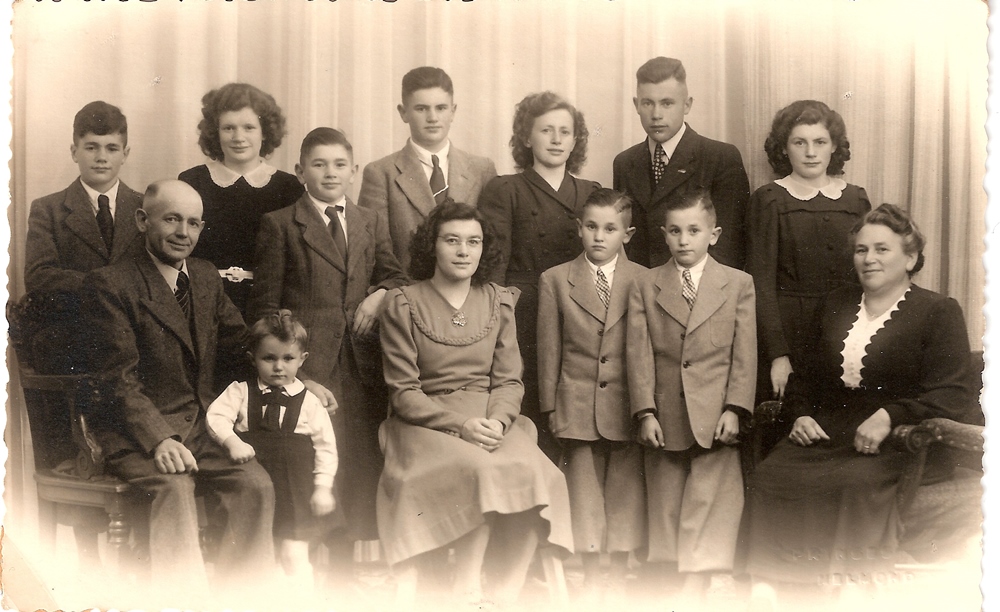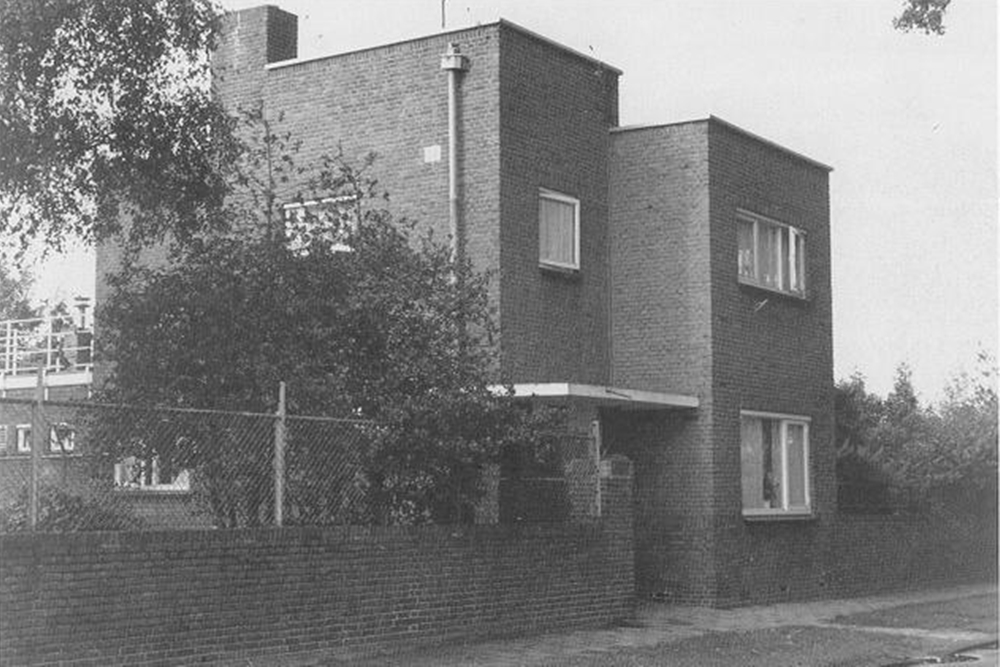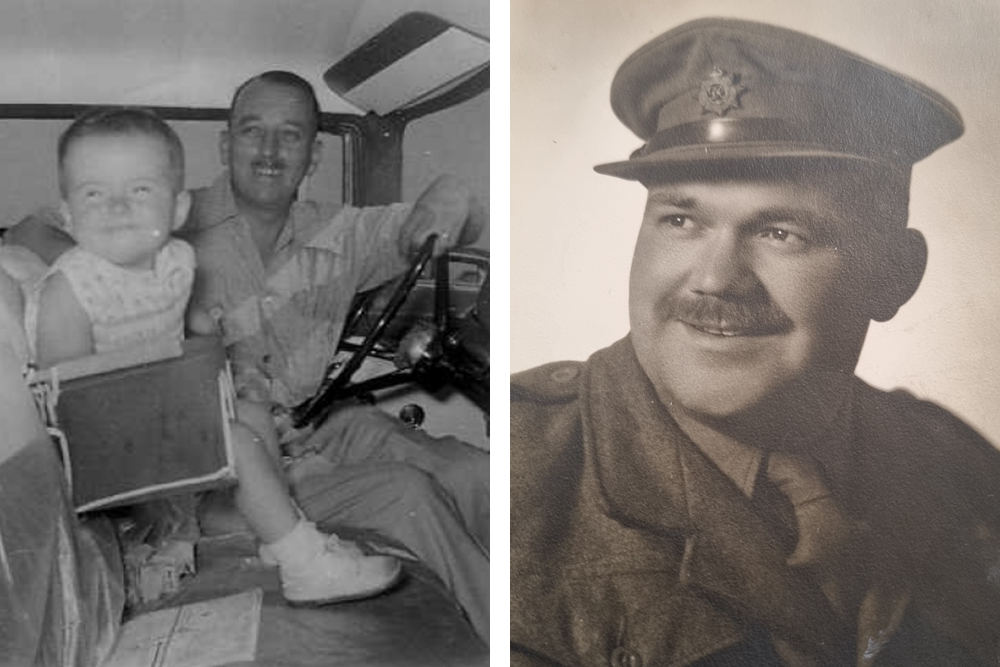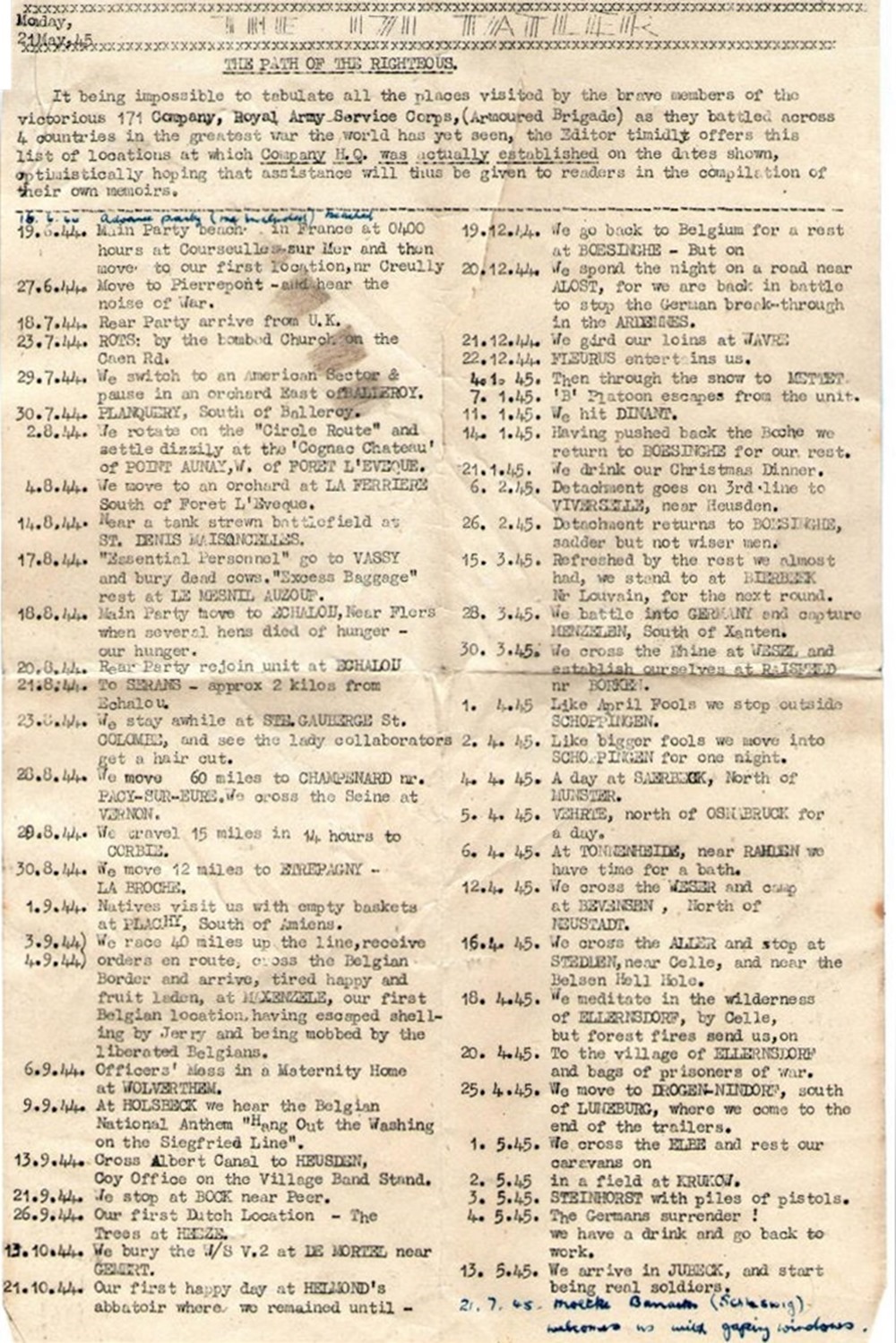British soldiers in an abattoir in Helmond
On 25 September 1944 Helmond was liberated by British troops. Soon the whole town changed into a rest centre, an encampment with maintenance troops, where men could rest and equipment could be repaired. This required much space. Schools and other public buildings were requisitioned, but private families also had troops billeted with them. The town paid the expenses. This could amount to 1.25 guilders if the family had an officer staying in a bed. Ordinary soldiers that were not able to get a bed only brought in 20 cents per night.[1]
During the war the Deurnescheweg in Helmond looked completely different than the present Deurneseweg. The part of it that ran south of the railway track is today called Rooseindsestraat. At the end of the 1920s a new public abattoir had been built at that location to improve hygiene and to enable slaughtering outside the town.[2] On 18 September 1930 the new abattoir was opened by the then mayor Van Hout.[3]

The abattoir at the Deurnescheweg (at the far right the company house of the machinist). Source: Collection RHCe / Fotoatelier Prinses, 14378.
Well over a year before the opening, on 29 August 1929 J. Snijders was appointed to the post of machinist for the engine room.[4] This position came with a company house. This house was assigned the address Deurnescheweg 3a and was located on the right side of the entrance of the abattoir. Later this address was changed to Rooseindsestraat 7 and after that it became number 25 of the same street. The building is still there.
Johannes Snijders was born on 7 October 1897 in Gemert. On 9 August 1923 he married Hendrika Maria Kerkhof Erp. She was born on 23 March 1903 in Den Bosch. They had twelve children. Johannes Snijders died on 12 October 1958 at the age of 61.[5] During the war British soldiers were quartered there. Son Sjef Snijders remembers two officers well. They were called Ron and Ken.[6] They were the only two officers that were quartered at their home. Sjef could not understand them as he would just turn seven in December 1944. But in 2022 he was still able to recognise Ron from a photograph.
Helmond after its liberation
After the liberation of Helmond on 25 September 1944, the office, the stables and the outbuildings of the abattoir were requisitioned by the British by 1 October.[7] On 21 October Captain David Ronald George (247545) was quartered in the home of the machinist, followed on 24 October by Captain Kenneth Melville (247880). A granddaughter of Captain George confirmed that her grandfather was called Ron.[8]
Both Captains George and Melville served with the Royal Army Service Corps (R.A.S.C.) of the 11th Armoured Division. The R.A.S.C. had the tasks to supply and to support. Both officers were mentioned in the January 1944 War Diary of the headquarters of the Commander of the R.A.S.C.’s 11th Armoured Division. At the time both were still Lieutenants.[9]
They both served with the 171st Company, R.A.S.C.[10] This unit was responsible for supplying the 29th Armoured Brigade, which was part of the 11th Armoured Division. It was this 171st Company that was transferred to the abattoir in Helmond on 21 October.[11] They wrote about it themselves in the 171st Tatler: "21.10.44 Our first happy day at Helmond's abbatoir where we remained until 19.12.44."[12]
George and Melville were to remain in Helmond until 9 December and 19 December, respectively.[13] On 11 April 1945 the buildings of the abattoir were released again.[14]
Definitielijst
- Brigade
- Consisted mostly of two or more regiments. Could operate independently or as part of a division. Sometimes they were part of a corps instead of a division. In theory a brigade consisted of 5,000 to 7,000 men.
Ken Melville
Lance-Corporal Kenneth Melville (129470) was born in 1916, and at the start of the war he served in the R.A.S.C. unit of the 51st (Highland) Division. At the beginning of January 1940 the 51st Division was shipped to France.[15] During the German invasion of France in May 1940 the division was in the area of Rémeling, in the northeast of France, along the German border.[16] One month later the division was sent back to the Canal, and in early June the division was near Saint-Valery-sur-Somme. Plans were made to evacuate from Le Havre, but this harbour town could no longer be reached.[17] Some troops were able to evacuate from Saint-Valery, but on 12 June 1940 the majority of the division was forced to surrender in that town to General Rommel’s 7th Panzer Division.[18]
Rommel wrote about this to his wife: "The battle is over here. To-day one corps commander and four division commanders presented themselves before me in the market square of St. Valéry, having been forced by my division to surrender. Wonderful moments!" The corps that surrendered was the French 9th corps led by General Ihler. General Fortune, commander of the 51st (Highland) Division served under this corps and also surrendered.[19]
Yet Melville was far away from these harbours. On 14 June he and his unit were in Metz. From there they went south, to Baume-les-Dames. Here they were taken prisoners of war on 18 June. They were taken to the Vauhan barracks, east of Dijon. These French barracks had been converted to the Germans’ prisoner of war camp Frontstalag 142.[20]
On 20 September 1940 Melville managed to escape in civilian clothes by climbing over a wall, together with three other soldiers of his unit. These were privates Ronald Walter James[21] Quickenden (128386), J.A. Petrie-Ritchie (130802) and A. Crowe (127451). As early as the next day they were able to reach Vichy-France. Their journey continued via Lyon, to finally reach Valence by 7 October. Here they were arrested and were taken to Grenoble. A week later they were transferred to Fort Saint-Jean in Marseille.[22]
They were obviously released in Marseille at some point in time. On 22 December three of the four of them – Petrie-Ritchie had gone the day before – left and took the train to Collioure, less than 20 kilometres from the Spanish border. From there they walked towards Banyuls-sur-Mer where they crossed the border into Spain. There they were picked up again and held for eight weeks to ultimately arrive at Gibraltar.[23]
Petrie-Ritchie also managed to reach Spain, and the four men left Gibraltar on 11 March 1941 to reach Gourock, Scotland,[24] on 17 March 1941. On 15 July 1941[25] Melville was presented with the Military Medal for "distinguished services in the field".[26] It is unknown whether he got this award for his escape or for the fighting during the days in May. His three fellow escapees did not receive an award.
On 10 October 1942 Melville was promoted from Cadet to 2nd Lieutenant[27] with the new service number 247880. On 10 April 1943 this was followed by his promotion to Lieutenant.[28] On 10 March 1944 he was transferred from the 173th Company, R.A.S.C. to the 171st Company.[29] On 22 May he was promoted to Temporary Captain.[30] He had this rank when he finally arrived in Helmond.
A few months earlier, during the landings in Normandy, Melville was so close to the front that he was fired upon by the Germans. In the early morning of 19 June 1944 the 171st Company had landed at Juno Beach near Courseulles-sur-Mer.[31] The troops went inland, going south. Captain Gainsford wrote the following about this: "Our Company Sergeant Major and Ken Melville are shot at in Reviers and in our location, and all together it seems best to keep alert and I keep my gun pretty handy."[32]
After several wanderings through Normandy they crossed the Seine near Vernon at the end of August.[33] They continued rapidly and crossed the Albert canal toward Heusden-Zolder on 13 September[34]. A mere two weeks later they reached Dutch territory and settled in the woods of Heeze.[35]
Gainsford wrote about Heeze: "It's another of those locations where the people appear like flies around a cowpat! And in no time we are mobbed completely by masses of men. […] They are pretty decent people, and speak quite good English."[36] Ultimately on 21 October the company reached Helmond by De Mortel.[37]
Definitielijst
- invasion
- Armed incursion.
Ron George
Corporal David Ronald George (7522072) was born on 31 January 1917. In 1939, after a study programme in public health at the University of Liverpool he joined the army in 1939.[38] There he served with the Royal Army Medical Corps and, like Melville, promptly was sent to France.[39] According to his granddaughter, George left France on board the RMS Lancastria on 17 June 1940. During Operation Aerial this passenger vessel was deployed to evacuate the British Expeditionary Force from France, similar to earlier evacuations from Dunkirk. Just after the Lancastria had departed from the harbour of Saint-Nazaire, it was attacked by German bombers. Thousands of people lost their lives.
George managed to escape the sinking ship because, according to this granddaughter, he was close to the exit. Nevertheless, he was reported as missing.[40] However, after a couple of months this was corrected.[41] He did manage to scare the life out of his cousin when they met at Leeds railway station. His cousin thought he had seen a ghost...[42]
Like Melville, George also got promoted to the rank of officer. On 3 October 1942 he was promoted from Cadet to 2nd Lieutenant with the new service number 247545.[43] In 1943 this was followed by his promotion to Lieutenant.[44] On 4 January 1944 he was transferred from the 18th Light Field Ambulances to the 171th Company[45], and early in 1944 he was again promoted to Temporary Captain[46]. He entered Helmond with the same rank as Melville. During his stay in Helmond, George served as supply officer of the company. On 23 October he was also made responsible for the supply of charcoal to the division the unit was serving, the 11th Armoured Division.[47]
At least once, on 9 August 1945, he was "mentioned in dispatches".[48] This was done as he had performed a special activity not qualifying for an award. Captain Ron George died on 13 August 2000 at the age of 83.[49]
Other soldiers
During the same time that the Captains Melville and George were quartered at the abattoir, we see that other soldiers were also quartered in the area. As of 21 October three soldiers were quartered at Deurnescheweg 9, until 28 November, 15 and 16 December respectively.[50]
At Deurnescheweg 12, opposite the abattoir, two soldiers and a corporal were quartered from 23 October until 4 December, and at Deurnescheweg 16 three soldiers were quartered from 20 October until 14 December.[51] Whether these soldiers all belonged to the same unit as George and Melville is not known, but according to the data and location it is likely.
Jim Hooper served in the 171st Company, and after the war he wrote a booklet about his war experiences. He writes about the weather becoming colder in October and that he and two others went looking for a better place to stay than the truck in which they had slept until then. "We found a billet in a row of small terraced houses a few hundred yards from the abbatoir. Mijnheer and Mevrouw Eerenbeek and their two children, a girl of six or seven and a boy around four […] readily provided a bedroom with three mattresses on the floor."[52] He wrote about the food shortage in the household and some chocolate the three men brought for the children. This was immediately confiscated by the mother to keep until Sinterklaas. The next day they brought some more chocolate of which the children were allowed a piece.[53]
The Eerenbeek family was probably the Van den Eerenbeemt family. The father, Franciscus Antonius van den Eerenbeemt, was married to Maria Johanna Vogels.[54] They did have two children, daughter Maria and son Hendricus. Their exact dates of birth are unclear, probably both in January, one in 1935[55] and one in 1936.[56] The family lived at Deurnescheweg 19, later named Rooseindsestraat 85.[57]
Hooper said there was not much to do at the abattoir. The Germans had already killed or taken most of the cattle in the area. Occasionally an animal was slaughtered, although most animals were already dead when they were brought in, killed by shell fire in the area.[58]
On 27 November a number of soldiers were permitted visit the so-called ENSA Show in Deurne. ENSA was the Entertainments National Service Association; this organisation arranged shows and concerts for the overseas troops. Unfortunately when arriving in Deurne the soldiers found that the show was not more than a movie that everyone in the company had already seen at least twice before.[59]
One of the occasions that left an impression on the unit was the crash near Helmond of a German fighter jet, a Messerschmitt Me 262. On 28 November this aeroplane was taken down and it crashed within 100 meters of the unit. Two soldiers were slightly injured by the explosion.[60]
According to a report of the municipality on 24 December the British forces were relieved by the Canadians, who would stay at the abattoir until 10 April 1945. Unfortunately, it is not known which Canadian units were involved.[61]
Definitielijst
- billet
- To lodge soldiers in a particular place, especially a civilian's house.
Captains George and Melville after Helmond
On 9 December 1944 Captain George left Helmond. He left with a number of soldiers in the direction of Boezinge, near Ypres in Belgium, to prepare for the arrival of the company. A day later Captain Melville was sent to Nijmegen with 10 trucks to collect Dutch patriots and to drop them off at Horst, at the reconnaissance unit of the 11th Armoured Division. On the 19th Melville finally left Helmond with the rest of the company.[62]
On 19 December 1944, the 171st Company left Helmond for a well-earned rest period in Boezinge. They did not get very far, as the next day at the Belgian town of Aalst they were deployed to the Ardennes, where the Battle of the Bulge had just begun. They arrived at Fleurus via Wavre on the 22nd. Gainsford: "Found the Coy damnably busy. […] The German counter-offensive is dead serious, and a dim view is taken as it caught the Yanks pretty unawares."[63]
At the end of December the company was responsible for supplying not only the 29th Armoured Brigade, but also the complete 6th Airborne Division. This lasted only a few days.[64] On 11 January the company reached Dinant. From this location they were finally able to go to Boezinge where they arrived on 14 January. A long period of rest followed, including the postponed "Christmas dinner" on 21 January 1945.[65]
On 23 March Captain Melville could go on leave to the United Kingdom. When exactly he returned is unclear, but he was back with his unit on 6 April.[66]
During the night of 28 to 29 March[67] the unit entered Germany, crossing the river Rhine at Wesel two days later. At the beginning of May, just after the German surrender, they were able to cross the Elbe to then reach Jübek, under Denmark.[68] On 24 August 1945 Captain George was transferred to the R.A.S.C. headquarters of the 11th Armoured Division. Then in early September Captain Melville went on leave again to the United Kingdom, after which on 16 September he returned and was appointed deputy commander.[69]
At the end of 1945 there were many shifts in officers within the unit. Many had already been sent home, and only a few remained. On 23 October the commander of the 171th Company, Major F.H. Everingham and some of the other officers left the service, after which Melville took over command of the unit. This lasted until 21 November when Major J.D. Crane took over command. Then on 25 November Melville could again go on leave to the United Kingdom. On 12 December 1945 he would again return to the company.[70] Unfortunately it is unknown when exactly Captain Ken Melville and Captain Ron George were finally allowed to return home.
Notes
- Regionaal Historisch Centrum Eindhoven, 11004 Gemeentebestuur Helmond, 1942-1967, 598 Inkwartiering geallieerde strijdkrachten - Declaraties.
- Zuid-Willemsvaart, 29 March 1928.
- Zuid-Willemsvaart, 18 September 1930.
Slachthuis met pensioen, Werkend Verleden in Helmond, No. 11 October 1997. - Zuid-Willemsvaart, 20 Augustus 1929.
- Family tree of the Snijders family based on RHce population records.
- Sjef Snijders, telefoongesprek 3 January 2022.
- Regionaal Historisch Centrum Eindhoven, 12028 Gemeentelijk slachthuis Helmond, 1925-1986, 52 Dienstgebouw aan de Deurneseweg Schade als gevolg van oorlogshandelingen 1940-1947.
Regionaal Historisch Centrum Eindhoven, 11004 Gemeentebestuur Helmond, 1942-1967, 1668 Onroerend goed gevorderd door de geallieerde strijdkrachten. - The Melville family, mailwisseling januari 2022.
- The National Archives, WO 171/461, 11th Armoured Div CRASC, 1944.
- The National Archives, WO 171/2401, 171 Company, 1944.
- The National Archives, WO 171/461, 11th Armoured Div CRASC, 1944.
- The 171 Tatler, 21 May 1945.
- Regionaal Historisch Centrum Eindhoven, 11004 Gemeentebestuur Helmond, 1942-1967, 598 Inkwartiering geallieerde strijdkrachten - Declaraties.
- Regionaal Historisch Centrum Eindhoven, 11004 Gemeentebestuur Helmond, 1942-1967, 1668 Onroerend goed gevorderd door de geallieerde strijdkrachten.
Regionaal Historisch Centrum Eindhoven, 12028 Gemeentelijk slachthuis Helmond, 1925-1986, 52 Dienstgebouw aan de Deurneseweg Schade als gevolg van oorlogshandelingen 1940-1947. - Monty's Highlanders, page 10.
- Monty's Highlanders, page 14.
- Monty's Highlanders, page 17.
- Monty's Highlanders, page 20.
- The Rommel Papers, page 66.
- The National Archives, WO 373/60/727 – 19 March 1941.
- The London Gazette, 8 February, 1944, page 673.
- The National Archives, WO 373/60/727 – 19 March 1941.
- The National Archives, WO 373/60/727 – 19 March 1941.
- The National Archives, WO 373/60/727 – 19 March 1941.
- The London Gazette, 11 July, 1941, page 4047.
The National Archives, WO 373/60/727 – 19 March 1941. - The National Archives, WO 373/60/727 – 19 March 1941.
- The London Gazette, 10 November, 1942, page 4922.
Forces-War-Records.co.uk. - Forces-War-Records.co.uk.
- The National Archives, WO 171/2401, 171 Company, 1944.
- Forces-War-Records.co.uk.
- The 171 Tatler, 21 May 1945.
My War Diary, page 6
The National Archives, WO 171/2401, 171 Company, 1944. - My War Diary, page 7.
- The National Archives, WO 171/2401, 171 Company, 1944.
- The National Archives, WO 171/2401, 171 Company, 1944.
- The 171 Tatler, 21 May 1945.
The National Archives, WO 171/2401, 171 Company, 1944. - My War Diary, page 90.
- The 171 Tatler, 21 May 1945.
The National Archives, WO 171/2401, 171 Company, 1944. - The Melville family, mailwisseling januari 2022.
- Forces-War-Records.co.uk.
- Forces-War-Records.co.uk.
- Forces-War-Records.co.uk.
- The Melville family, mailwisseling januari 2022.
- The London Gazette, 30 October, 1942, page 4750.
- Forces-War-Records.co.uk.
- The National Archives, WO 171/2401, 171 Company, 1944.
- Forces-War-Records.co.uk.
- The National Archives, WO 171/2401, 171 Company, 1944.
- The London Gazette, 7 August, 1945, page 4055.
- The Melville family, mailwisseling januari 2022.
- Regionaal Historisch Centrum Eindhoven, 11004 Gemeentebestuur Helmond, 1942-1967, 598 Inkwartiering geallieerde strijdkrachten - Declaraties.
- Regionaal Historisch Centrum Eindhoven, 11004 Gemeentebestuur Helmond, 1942-1967, 598 Inkwartiering geallieerde strijdkrachten - Declaraties.
- Seven Christmasses, J.D. Hooper, page 47.
- Seven Christmasses, J.D. Hooper, page 47.
- Op basis van RHCe bevolkingsadministratie.
- Zuid-Willemsvaart, 4 January 1935.
- Zuid-Willemsvaart, 31 January 1936.
- Op basis van RHCe bevolkingsadministratie.
- Seven Christmasses, J.D. Hooper, page 47-48.
- The National Archives, WO 171/2401, 171 Company, 1944.
- The National Archives, WO 171/2401, 171 Company, 1944.
- Regionaal Historisch Centrum Eindhoven, 12028 Gemeentelijk slachthuis Helmond, 1925-1986, 52 Dienstgebouw aan de Deurneseweg Schade als gevolg van oorlogshandelingen 1940-1947.
- The National Archives, WO 171/2401, 171 Company, 1944.
- My War Diary, pagina 183-184.
- The National Archives, WO 171/2401, 171 Company, 1944.
- The 171 Tatler, 21 May 1945.
The National Archives, WO 171/6214, 171 Company, 1945. - The National Archives, WO 171/6214, 171 Company, 1945.
- The National Archives, WO 171/6214, 171 Company, 1945.
- The 171 Tatler, 21 May 1945.
- The National Archives, WO 171/6214, 171 Company, 1945.
- The National Archives, WO 171/6214, 171 Company, 1945.
Definitielijst
- Brigade
- Consisted mostly of two or more regiments. Could operate independently or as part of a division. Sometimes they were part of a corps instead of a division. In theory a brigade consisted of 5,000 to 7,000 men.
- offensive
- Attack on a smaller or larger scale.
Information
- Article by:
- Jeroen Koppes
- Translated by:
- Liesbeth Vrieze-Risseeuw
- Published on:
- 05-05-2022
- Feedback?
- Send it!
Related books
Sources
- DELAFORCE, P,, Monty's Highlanders.
- GAINSFORD, A.P., My War Diary, 2012.
- HOOPER, J.D., Seven Christmasses.
- LIDDELL HART, B.H., The Rommel Papers, Da Capo Press, 1953.
- Forces-War-Records.co.uk.
- HOOF, G. VAN, Slachthuis met pensioen, Werkend Verleden in Helmond, No. 11 October 1997.
- Regionaal Historisch Centrum Eindhoven, 11004 Gemeentebestuur Helmond, 1942-1967, 598 Inkwartiering geallieerde strijdkrachten - Declaraties.
- Regionaal Historisch Centrum Eindhoven, 12028 Gemeentelijk slachthuis Helmond, 1925-1986, 52 Dienstgebouw aan de Deurneseweg Schade als gevolg van oorlogshandelingen 1940-1947.
- Regionaal Historisch Centrum Eindhoven, 11004 Gemeentebestuur Helmond, 1942-1967, 1668 Onroerend goed gevorderd door de geallieerde strijdkrachten.
- The 171 Tatler, 21 May 1945.
- The London Gazette, 11 July, 1941, page 4047.
- The London Gazette, 30 October, 1942, page 4750.
- The London Gazette, 10 November, 1942, page 4922.
- The London Gazette, 8 February, 1944, page 673.
- The London Gazette, 7 August, 1945, page 4055.
- The National Archives, WO 171/461, 11th Armoured Div CRASC, 1944.
- The National Archives, WO 171/2401, 171 Company, 1944.
- The National Archives, WO 171/6214, 171 Company, 1945.
- The National Archives, WO 373/60/727 – 19 March 1941.
- Zuid-Willemsvaart, 29 March 1928.
- Zuid-Willemsvaart, 20 August 1929.
- Zuid-Willemsvaart, 18 September 1930.
- Zuid-Willemsvaart, 4 January 1935.
- Zuid-Willemsvaart, 31 January 1936.
With thanks to
- The George family.
- The Scott family.
- The Melville family.
- The Snijders family.
- The Thielen family.
- Regionaal Historisch Centrum Eindhoven.
- Fred Bolle.
- Giel van Hooff.
- Antoine Leprince.
- Anne Palmer.
- Kevin Prenger.
- Liesbeth Vrieze-Risseeuw.









